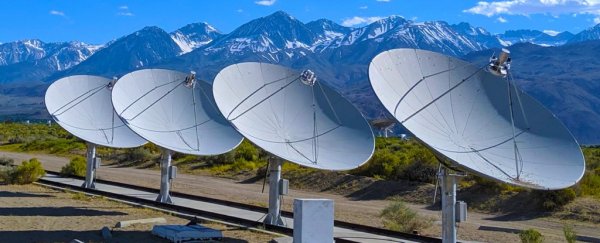They're some of the most mysterious and powerful events in space, and we don't know what causes them – but in a major feat, astronomers have just traced another weird signal to its source.
The strange, energetic phenomena are called fast radio bursts (FRBs), and for just the second time in history – both announced in the space of a week, no less – scientists have traced a one-off FRB to the galaxy where it came from.
There's not much we know about these events. Fast radio bursts are intense emanations of electromagnetic radiation that originate from somewhere outside our galaxy.
Scientists only discovered the phenomenon in 2007, but since then we've detected dozens of these brilliant bursts of radio waves, although scientists suspect they're actually happening all the time.
While the exact causes of FRBs remain an ongoing matter of scientific debate, thanks to recent advances in astronomy we've at least started pinpointing their origins.
The newly identified burst, called FRB 190523, was detected less than a fortnight ago on May 23. According to astronomers at Caltech's Owens Valley Radio Observatory (OVRO), it actually originated some 7.9 billion light-years across space – so, no matter what it was that produced this powerful flash of radiation, it took place a long time ago in a galaxy far, far away.
 (Caltech/OVRO/V. Ravi)
(Caltech/OVRO/V. Ravi)
Above: DSA-10's field of view (left), the magnified distant galaxy (middle), and FRB 190523's burst profile (right) in the radio spectrum.
The surprising thing, says OVRO astronomer Vikram Ravi, is that the distant, massive galaxy responsible for FRB 190523 actually appears to resemble our own galaxy in terms of its size and age; a notion that challenges some previous thinking on the kinds of galactic environments that might produce FRBs.
"This finding tells us that every galaxy, even a run-of-the-mill galaxy like our Milky Way, can generate an FRB," says Ravi.
In the developing science of fast radio bursts, FRB 190523 is an example of what's known as a non-repeating burst: a brief one-off signal of radio waves.
By contrast, much of what we know about FRB phenomena to date comes from study of a repeating burst event called FRB 121102, which was first reported in 2014, before later becoming the first-ever FRB to have its galactic origins pinpointed.
In comparison, tracking a one-off signal like FRB 190523 – fleeting bursts that only show up for scant milliseconds in our scopes – is much harder.
"Finding the locations of the one-off FRBs is challenging because it requires a radio telescope that can both discover these extremely short events and locate them with the resolving power of a mile-wide radio dish," says Ravi.
Thankfully, as OVRO's Deep Synoptic Array–10 (DSA-10) detected the burst, researchers were able to use data from the radio telescope together with data from the Keck Observatory in Hawaii. In the near future, the full DSA array (which will eventually add 100 extra dishes to its current 10) is expected to be able to catch more than 100 FRBs annually.
For now, though, pinpointing one-off FRBs is cutting-edge science. The first time such an accomplishment was ever announced was just last Thursday, when an international team reported the origins of FRB 180924, which was also generated from a Milky Way-esque galaxy about 3.6 billion light-years away.
"This is the big breakthrough that the field has been waiting for since astronomers discovered fast radio bursts in 2007," said astro-engineer Keith Bannister from Australia's Commonwealth Scientific and Industrial Research Organisation (CSIRO) last week.
Before these two recent discoveries, FRB 121102 – the repeating FRB, traced in 2017 – had led some to propose fast radio bursts might only arise from young dwarf galaxies, populated with highly magnetic neutron stars called magnetars.
"The theory that FRBs come from magnetars was developed in part because the earlier FRB 121102 came from an active star-forming environment, where young magnetars can be formed in the supernovae of massive stars," says Ravi.
"But the host galaxy of FRB 190523 is more mellow in comparison."
Now that astronomers have traced the sources of two one-off FRBs, it's becoming clearer some of those assumptions might be due for a rethink, although there's still so much we don't know about FRBs – nor the differences between the one-off signals and the repeat bursts.
"The 'young magnetar' model works pretty well for 121102… but it has trouble explaining our burst, in particular the fact that it comes from a galaxy with not many young stars," Bannister told ScienceAlert last week, in relation to FRB 180924.
"So the theorists might need to go back to the drawing board to explain our burst by adjusting the young magnetar model, or finding a completely different explanation for our one."
So, what is it exactly about old stars that's making these brilliant bursts?
With new observational capabilities in the pipeline at the Deep Synoptic Array and elsewhere, we might not have to wait too long to find out.
The findings are reported in Nature.
